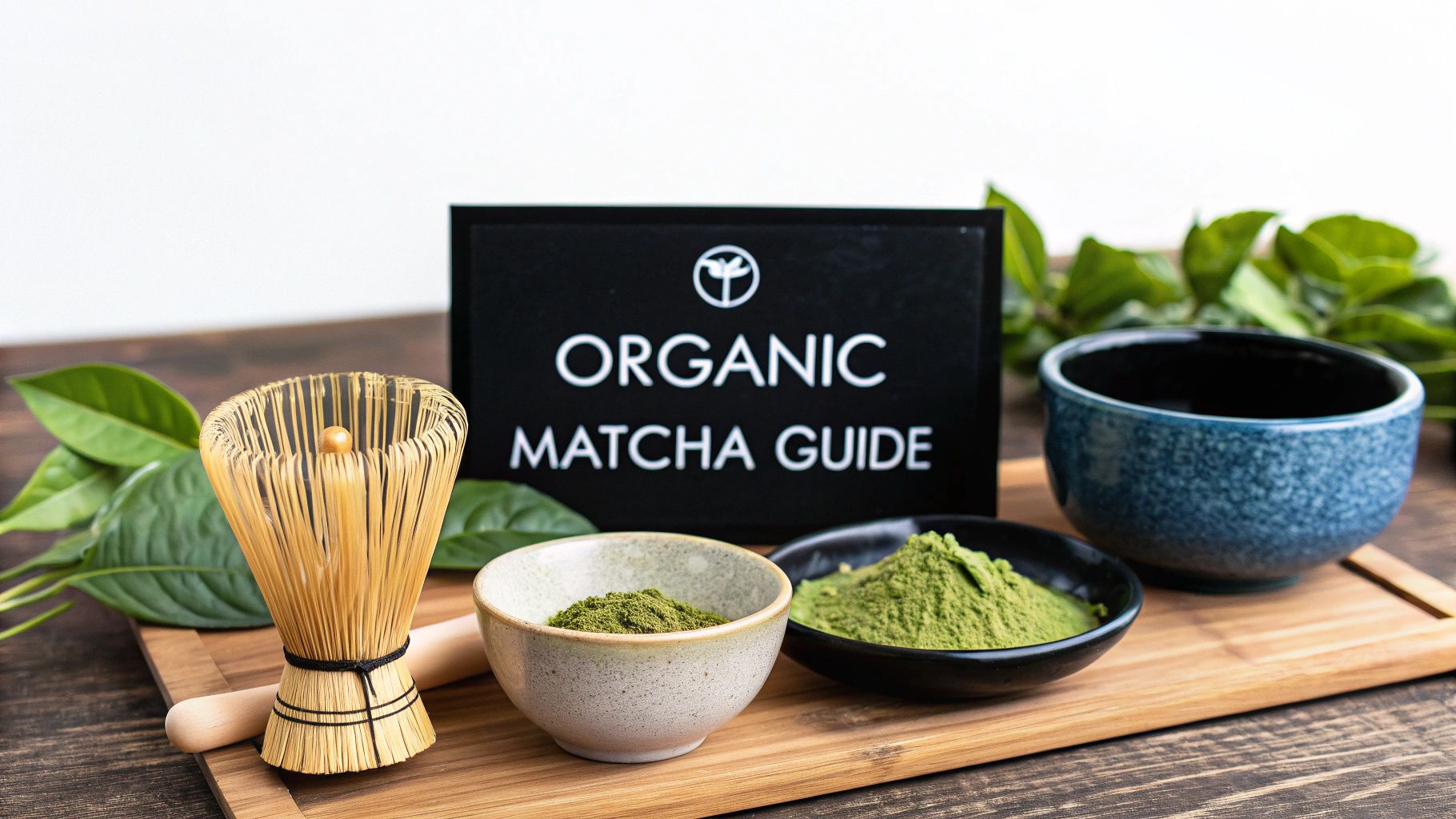Organic Japanese matcha is so much more than just a vibrant green powder. It’s a centuries-old tradition, a wellness ritual that delivers a unique sense of calm, focused energy. Unlike standard green tea where you steep the leaves, with authentic Japanese matcha, you consume the entire stone-ground leaf. This means you get a more concentrated source of nutrients and a far more complex, rich flavour—an experience we’ve perfected at Amatsu Matcha.
The Timeless Appeal of Japanese Matcha
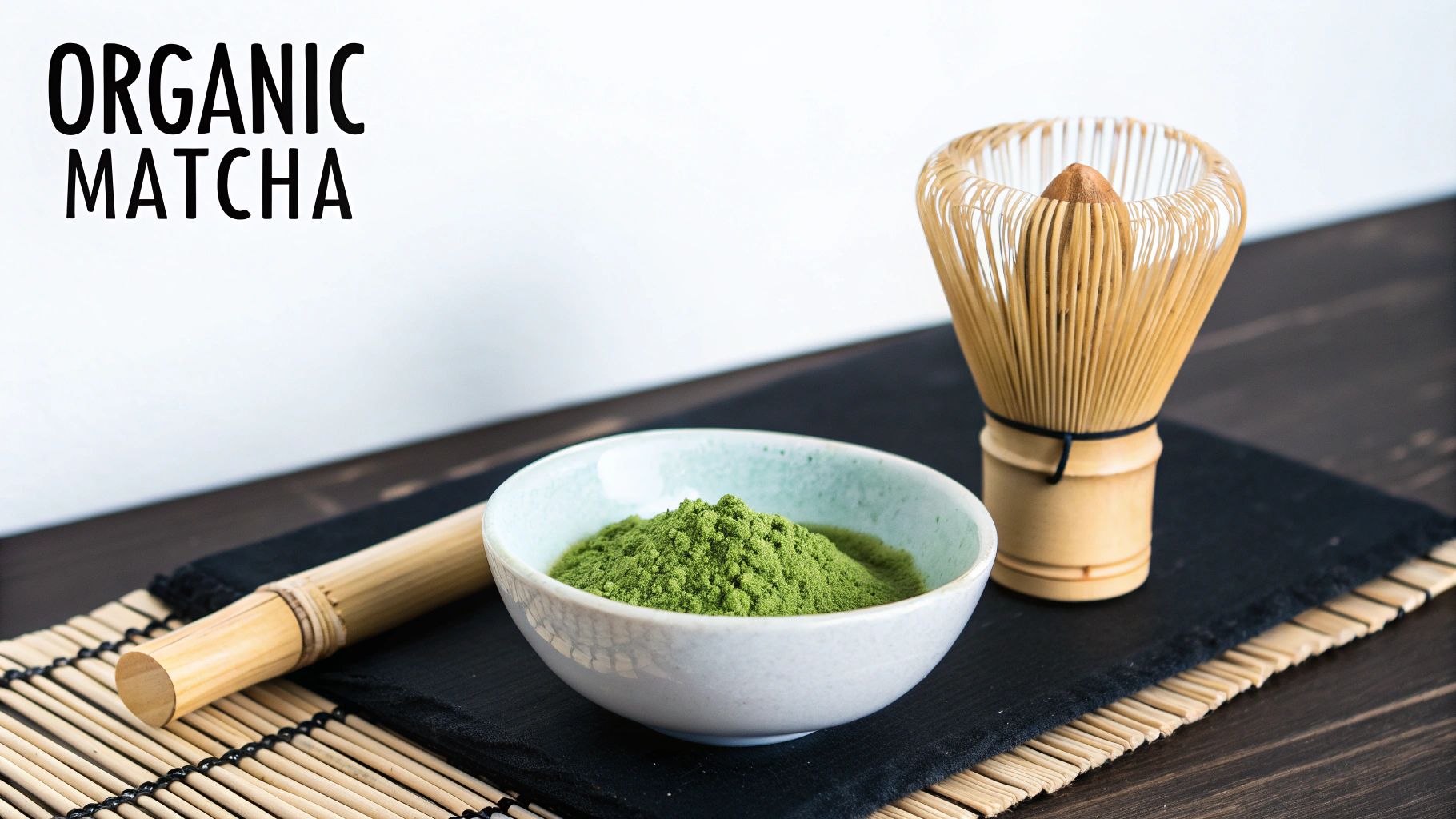
Far from being a fleeting trend, organic matcha from Japan has firmly established itself as a cornerstone of modern wellness routines here in the UK. Its journey from the quiet reverence of Zen Buddhist monasteries to the buzzing energy of today's wellness culture is a testament to its lasting appeal. This isn't just another green powder; it's a full-on sensory experience that transforms your day.
What really makes it special is the immediate impact it has on your senses. The electric green colour screams vitality. The rich, savoury umami flavour is a delight. And the feeling it leaves you with? A state of calm, focused alertness. It’s this unique combination that has so many people happily swapping their morning coffee for a mindful bowl of matcha.
From Ancient Ritual to Modern Staple
Part of matcha’s charm is its dual identity. It’s both an ancient ritual and a modern superfood. In our hectic lives, it offers a moment of quiet contemplation, turning a simple drink into a genuinely meaningful practice. That connection to tradition is a huge part of its appeal.
But let’s be honest, its popularity is also fuelled by a growing understanding of its powerful benefits. When you drink matcha, you are consuming the entire tea leaf. That means you get 100% of the nutrients, including potent antioxidants and amino acids. This crucial difference is something we explore in more depth when comparing Japanese tea vs. matcha.
Authentic Japanese matcha isn't merely a beverage; it's a wellness ritual. It embodies a principle of mindful consumption, where the preparation is as important as the drink itself, fostering a deep connection between mind and body.
The demand for high-quality, authentic products really shows how much people appreciate this. The UK's matcha market is set to grow from around £108 million in 2025 to over £400 million by 2035. That incredible growth clearly signals its shift from a niche item to a mainstream wellness staple.
Setting the Standard for Quality
As demand for matcha continues to rise, it becomes even more important to source the real deal. True organic matcha from Japan is the result of painstaking cultivation and production methods—a process that simply can't be replicated elsewhere.
This dedication to purity and quality is the foundation of Amatsu Matcha. We believe that to experience the true essence of this remarkable tea, you need a product that honours its heritage. Our commitment is to provide premium, first-harvest ceremonial-grade matcha that sets the standard for flavour, purity, and effectiveness. With Amatsu, every bowl you prepare is an authentic wellness experience, designed to elevate your daily routine.
The Journey from Shaded Leaf to Fine Powder
Transforming a simple tea leaf into the vibrant green powder we recognise as matcha is a story steeped in patience, tradition, and meticulous craftsmanship. It’s this carefully guarded process that sets authentic organic matcha from Japan worlds apart from common green tea powders, giving it a unique character and a powerful nutritional punch. Honestly, it’s less about manufacturing and more about pure artistry.
It all starts with a special kind of tea leaf known as tencha. Unlike the leaves used for regular green tea, these are grown under shade for about three to four weeks before being harvested. Think of it like drawing a curtain over the plants; this crucial step forces them to work harder to photosynthesise.
In response, the leaves kick their chlorophyll production into high gear, which is what gives top-tier matcha its famously brilliant green colour. Even more importantly, this shading process dramatically boosts the concentration of L-theanine, the amino acid behind matcha's renowned 'calm alertness'.
The Art of a Precise Harvest
When harvest time rolls around, only the youngest, most delicate leaves from the very top of the plant are selected. This first harvest, or Ichibancha, delivers the highest quality leaves, bursting with the richest flavour and nutrients. For ceremonial grade matcha, this selection is often still done by hand—a painstaking task ensuring only the absolute best leaves make the cut.
Once plucked, the leaves need to be processed immediately to stop them from oxidising, which would dull their colour and sap their nutritional value. They go through a gentle steaming, a critical step that halts any fermentation and locks in that bright hue and the subtle, savoury umami flavour. It’s this steaming that preserves the 'fresh-from-the-field' character defining real Japanese matcha.
The image below shows the key stages that take a shaded leaf and turn it into the final powder.
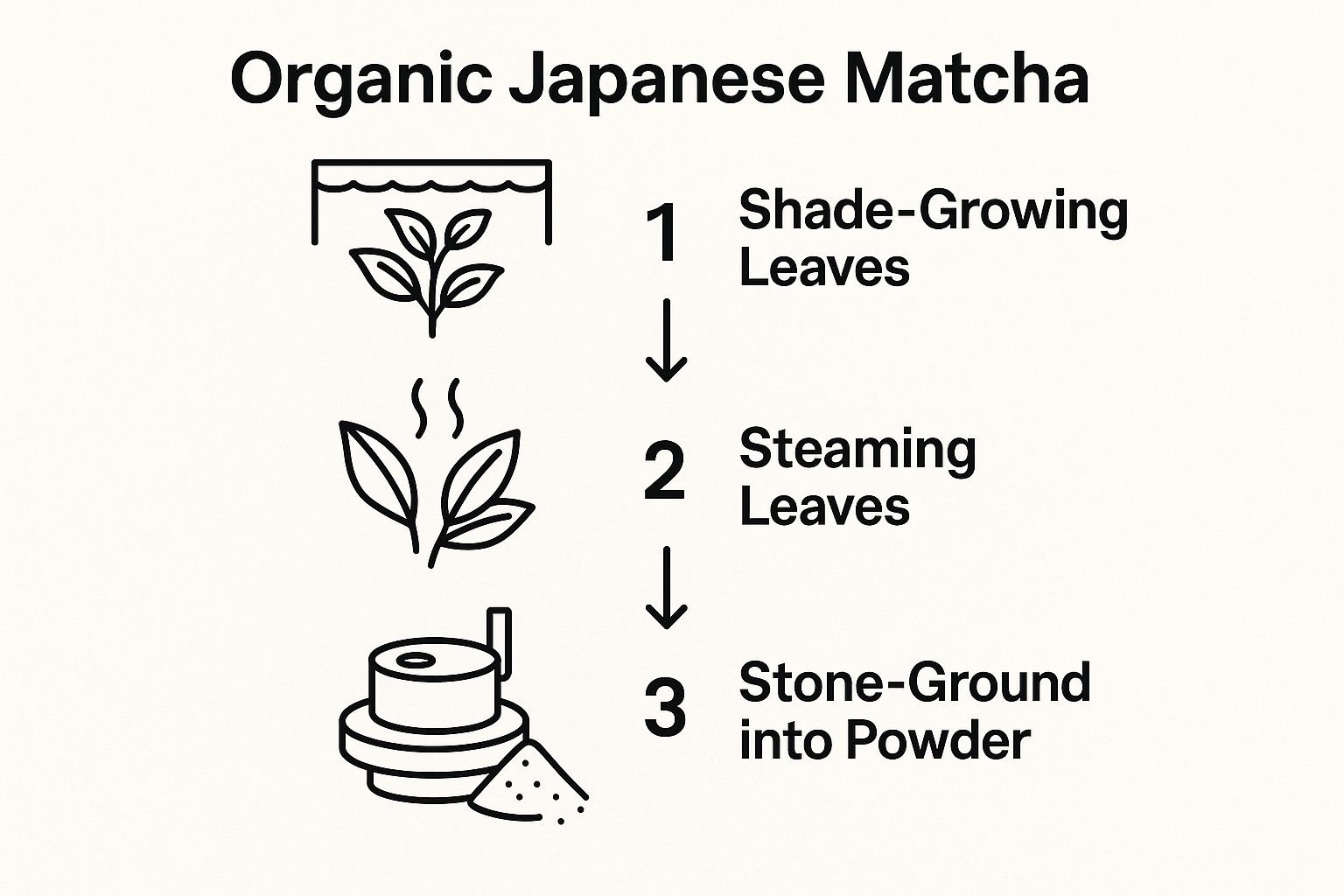
As you can see, every single part of the process—from the controlled shading to the careful grinding—is absolutely essential for creating true matcha.
From Dried Leaf to Silky Powder
After steaming, the leaves are gently dried. At this point, they are still whole and are known as tencha. To get them ready for their final transformation, the stems and veins are painstakingly removed, leaving behind only the purest, most flavourful part of the leaf. This de-stemming and de-veining is vital for getting that smooth, non-gritty texture you find in premium matcha.
The final, and most iconic, step is the grinding. True ceremonial grade matcha is ground slowly and deliberately into a micro-fine powder using traditional granite stone mills.
This traditional stone-grinding method is incredibly slow; it can take up to an hour just to produce 30-40 grams of matcha. This deliberate pace is non-negotiable, as it prevents the mills from getting hot, which would scorch the delicate leaves and ruin their flavour and aroma.
The result is a powder so fine—around 5-10 microns—that it feels like silk and dissolves perfectly in water, creating a creamy, frothy drink free of clumps or bitterness. This entire, unhurried journey explains why authentic organic matcha from Japan comes with a higher price tag. It isn't just a product; it’s the culmination of centuries of refined agriculture and artistry—a true labour of love you can taste in every sip of Amatsu Matcha.
How To Identify High-Quality Matcha
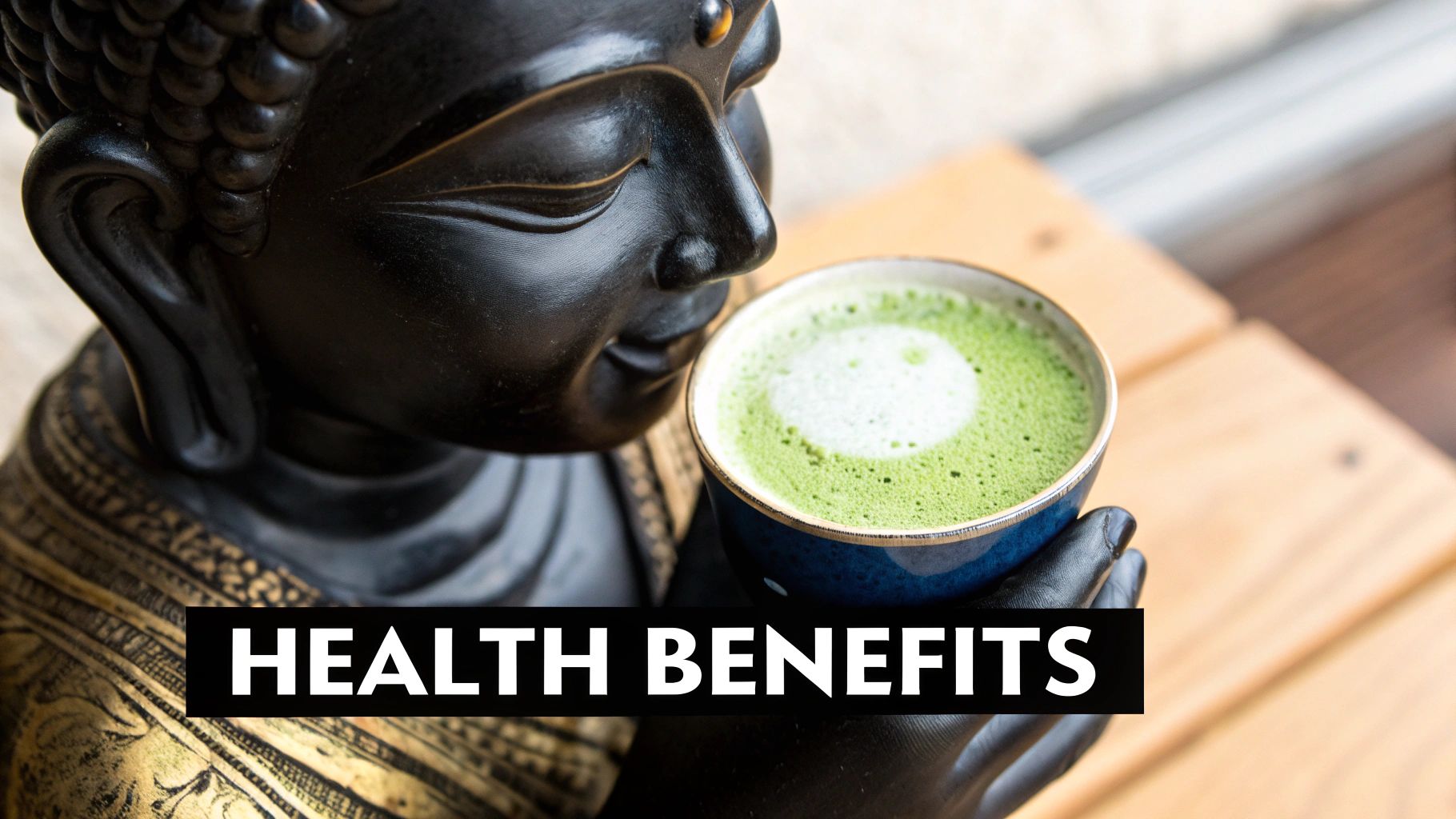
When you first start exploring the world of matcha, the sheer number of options can feel a bit overwhelming. But once you know the tell-tale signs of real quality, you'll be able to spot the good stuff in an instant. Finding high-grade organic matcha from Japan isn't about guesswork; it’s about using your senses to check for a few key markers of excellence.
What To Look For: Colour and Texture
Your first clue is always the colour. Truly exceptional matcha has a vibrant, almost luminous green hue. This brilliant colour comes from the shade-growing process, which ramps up chlorophyll production in the tea leaves. If you open a tin and find a dull, yellowish, or murky green powder, it’s a red flag for lower quality. That powder likely came from a later harvest or wasn't processed with care.
Next, get a feel for the texture. The best matcha is stone-ground into an incredibly fine powder, feeling almost like cornflour or talc. Rub a little between your fingertips—it should feel silky and smooth. If it feels gritty or coarse, it means the grinding was rushed, or worse, it contains stems and veins that will make your tea taste bitter.
The Importance of Aroma and Origin
The smell of high-quality matcha is just as revealing as its look. A premium powder should greet you with a fresh, sweet, and slightly grassy aroma. That sweet scent is a direct result of a high concentration of L-theanine, one of the amino acids that makes matcha so special. If you get a whiff of something stale or hay-like, the matcha is probably old or has been poorly stored, losing its flavour and potency.
Above all, there are two non-negotiables for authentic quality: a Japanese origin and organic certification. Japan has perfected the art of matcha cultivation over centuries, and their techniques are simply unmatched. Always check the label for "Product of Japan." Equally important, organic certification ensures the tea was grown without synthetic pesticides or fertilisers, giving you a purer, cleaner product.
It's a common mistake to think all matcha from Japan is top-tier. The grade makes a huge difference, and this is where understanding the distinction between ceremonial and culinary grades is key to crafting your perfect daily ritual.
To help you tell them apart, we've put together a quick comparison table. And for a more detailed look, you can explore our guide on choosing the best ceremonial grade matcha, which explains what sets the finest powders apart.
Ceremonial Grade vs Culinary Grade Matcha
This table breaks down the main differences to help you choose the right matcha for your needs, whether you're whisking a traditional tea or getting creative in the kitchen.
| Feature | Ceremonial Grade Matcha | Culinary Grade Matcha |
|---|---|---|
| Colour | Vibrant, electric green | Duller, often yellowish-green |
| Taste | Delicate, sweet, umami, with no bitterness | Bolder, more astringent, and slightly bitter |
| Texture | Ultra-fine, silky powder | Coarser texture, not as smooth |
| Harvest | First harvest (Ichiban-cha) from the youngest leaves | Later harvests (second, third) from more mature leaves |
| Best Used For | Drinking straight with water | Lattes, smoothies, baking, and cooking |
| Price | Higher | More affordable |
Ultimately, both grades have their place. Ceremonial is for savouring the pure, nuanced flavour of the tea itself, while culinary grade is designed to stand up to other ingredients.
Navigating The Global Matcha Shortage
Lately, finding genuine organic matcha has become more of a challenge. In 2025, the UK is one of the regions hit hardest by a global shortage of high-quality organic Japanese matcha. This scarcity is mainly down to extreme weather affecting key growing regions like Uji and Nishio, leading to much smaller crop yields. With demand in the UK still rising, this has understandably led to price hikes and empty shelves.
This is exactly why we created Amatsu Matcha. We were founded on a commitment to cut through these supply issues and provide a reliable source of authentic, first-harvest organic matcha from Japan. By partnering directly with esteemed growers in Uji, we ensure every tin we offer meets the highest standards of colour, texture, and flavour. When you choose Amatsu Matcha, you aren't just buying tea—you're investing in a consistently exceptional product that delivers the quality and wellness benefits you expect, every single time.
The Health Benefits of Authentic Japanese Matcha
Beyond its beautiful flavour and deep-rooted history, authentic organic matcha from Japan is a genuine powerhouse of health benefits. What makes it so special? Unlike regular teas, when you drink matcha, you’re consuming the entire stone-ground leaf. This means you get a far more concentrated dose of nutrients that work together to support both your mind and body.
This is all thanks to the unique Japanese growing methods, particularly the weeks spent shading the tea plants before harvest. It’s this painstaking process that transforms a simple tea leaf into a remarkable superfood. It's not just a drink; it's a functional food, and understanding the science behind its benefits shows why sourcing quality, organic matcha is so important.
Calm Alertness: The L-Theanine Effect
Have you ever wanted the focus you get from coffee but without the anxious jitters that can come with it? That's the magic of L-theanine, an amino acid found in abundance in shade-grown matcha. You can think of it as caffeine's natural, calming partner.
L-theanine encourages the production of alpha waves in the brain, the kind associated with a state of relaxed wakefulness. This is what creates that signature ‘calm alertness’ so many matcha drinkers love—a clear, focused mind that remains steady and composed. It’s the perfect state for productive work, creative sessions, or just navigating a busy day with a sense of ease. It’s a world away from the sharp spike and subsequent crash you often get from a strong coffee.
A Rich Source of Antioxidants
Matcha is absolutely packed with powerful antioxidants called catechins. The most famous and potent of these is epigallocatechin gallate (EGCG), a compound widely celebrated for its ability to help protect the body from oxidative stress.
Every day, our bodies deal with free radicals—unstable molecules that can damage cells, contributing to ageing and chronic illness. The high concentration of EGCG in matcha acts like a personal bodyguard for your cells, neutralising these harmful molecules and supporting your body's natural defences. This incredible antioxidant capacity is a cornerstone of matcha's reputation as a healthy choice. For a closer look at how it stacks up, check out our detailed guide on the wellness differences between pure matcha vs. green tea.
The global fascination with organic Japanese matcha isn't just about taste; it's deeply tied to its health credentials. Research shows it can have up to 137 times more antioxidants than standard steeped green tea and is recognised for its role in supporting metabolism and overall wellness.
This growing awareness is a key reason for its popularity, especially here in the UK where the demand for natural, sustainable products continues to rise.
Boosting Metabolism and Natural Detoxification
The benefits of organic matcha don't stop at the mind. That same EGCG that provides all the antioxidant protection has also been shown to have thermogenic properties. In simple terms, this means it can gently boost your metabolism, helping your body burn calories more efficiently. It’s a fantastic, natural partner for a healthy lifestyle and any weight management goals.
What about that vibrant green colour? That’s a direct result of the high chlorophyll content, developed during the all-important shading process. Chlorophyll is a natural detoxifier, known for helping the body cleanse itself of heavy metals and other toxins. So, with every sip of matcha, you’re getting a gentle, natural detox that helps purify your system from the inside out.
At Amatsu Matcha, we've harnessed these inherent benefits and elevated them with our functional blends:
- Amatsu Radiance: For a beauty-from-within ritual, this blend combines our premium organic matcha with collagen and hyaluronic acid to support radiant skin, healthy hair, and strong nails.
- Amatsu Shrooms: We’ve combined our premium organic matcha with functional mushrooms like Lion's Mane and Cordyceps to amplify cognitive benefits, giving you even sharper focus and mental clarity.
- Amatsu Strength: For those with fitness goals, this blend is boosted with creatine to support muscle power, endurance, and recovery, making it the perfect pre-workout ritual.
When you choose a high-quality organic matcha from Japan, you’re doing more than just enjoying a delicious tea. You are embracing a ritual that truly nourishes your entire being.
How To Prepare The Perfect Bowl Of Matcha
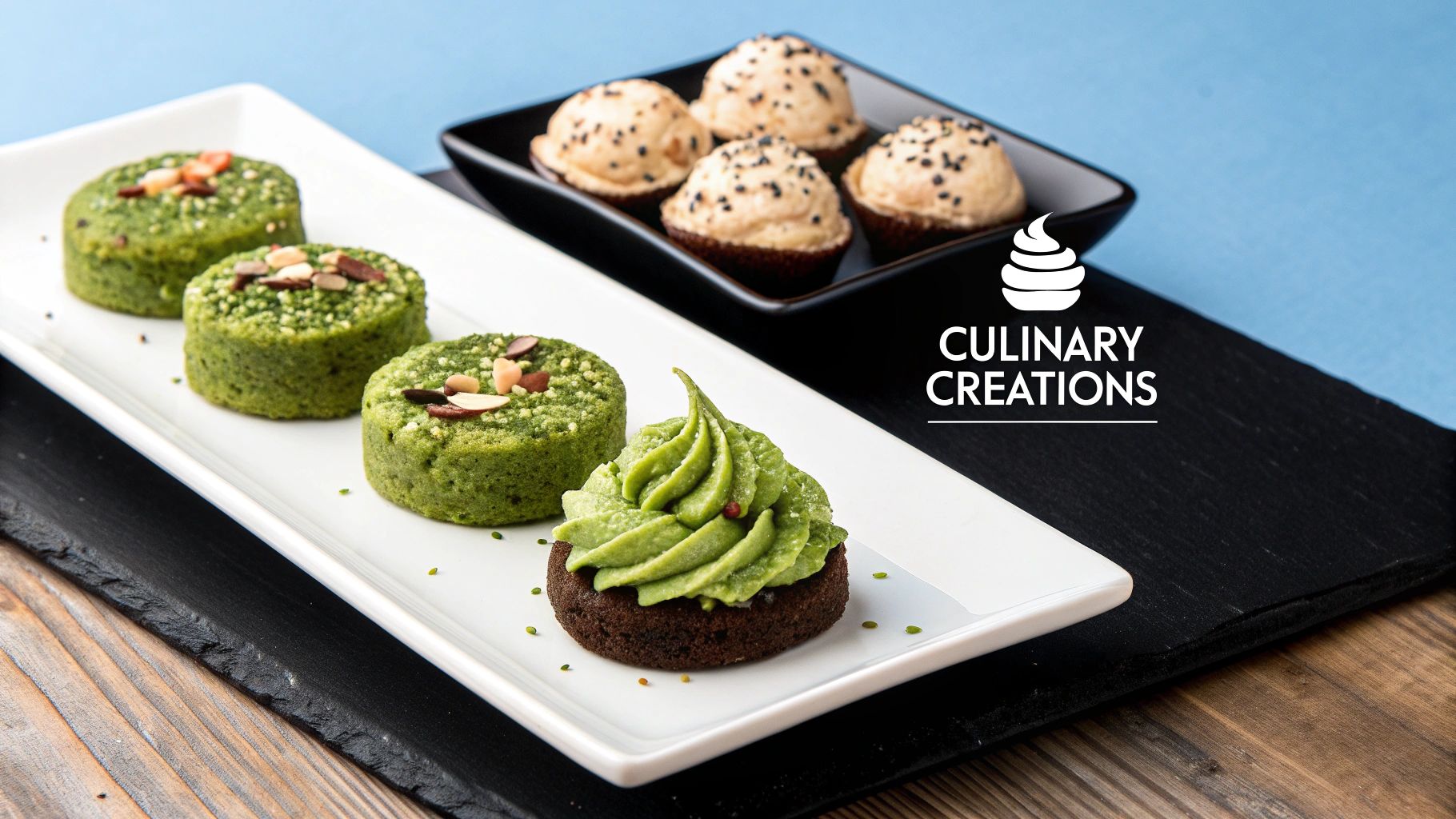
Making a bowl of matcha is so much more than just mixing up a drink. It’s a rewarding ritual, a small pocket of calm and focus in an otherwise busy day. The good news is that mastering the traditional technique is surprisingly straightforward and the key to unlocking the full, creamy flavour of your organic matcha from japan. All it takes is a few essential tools and a bit of practice.
The classic method relies on three simple items: a chawan (tea bowl), a chasen (bamboo whisk), and a chashaku (bamboo scoop). These aren't just for ceremony; each one is purpose-built to help you create a perfectly smooth, frothy bowl of matcha every single time.
The Traditional Method Step by Step
Following these steps will guide you in creating a beautiful and delicious bowl of matcha, turning a simple task into a mindful practice. The aim is to achieve a rich, creamy foam without a single clump in sight.
-
Warm Your Bowl: First things first, pour some hot water into your chawan to gently warm it. Swirl the water around for a moment, then tip it out and dry the bowl. This little step makes a big difference in keeping your tea at the ideal temperature.
-
Sift the Matcha: Use your chashaku to measure one to two scoops of matcha powder (that’s about 1-2 teaspoons) into a fine-mesh sieve held over the bowl. Sifting is non-negotiable! It breaks down any pesky clumps and is your secret to a silky-smooth finish.
-
Add Water: Gently heat some fresh, soft water to around 80°C (175°F). It’s really important not to use boiling water, as it will scorch the delicate tea leaves and leave you with a bitter-tasting brew. Pour about 60-70ml (roughly 2-3 ounces) of the hot water over your sifted powder.
-
Whisk Vigorously: Now for the fun part. Hold the bowl steady with one hand and, using your chasen, whisk the matcha and water together in rapid "W" or "M" shapes. Keep your wrist loose and focus on agitating the mixture quickly, almost like you're writing letters on the bottom of the bowl, but without actually scraping it.
-
Create the Foam: After about 15-20 seconds of whisking, you'll see a lovely layer of fine, creamy foam start to form. To finish, slow down your whisking and gently move the whisk across the surface to pop any larger bubbles. What you're left with is a perfect microfoam. Drink it straight away to enjoy the incredible flavour and texture.
Modern Twists for Everyday Routines
While the traditional preparation is a beautiful ritual, one of the best things about matcha is how well it fits into modern life. Whether you're after a morning pick-me-up or a pre-workout energy boost, there’s a way to make matcha work for you.
-
The Perfect Matcha Latte: For a wonderfully creamy latte, start by making a concentrated shot of matcha. Just follow the traditional method but use less water (about 30ml). Then, steam and froth 150ml of your favourite milk (dairy or plant-based works great) and pour it over the matcha shot.
-
The Power-Up Smoothie: Simply add a teaspoon of matcha powder straight into your blender along with your usual smoothie ingredients. It has a fantastic flavour that pairs beautifully with things like banana, spinach, pineapple, and a scoop of protein powder for a seriously nutrient-dense start to your day.
Choosing the right matcha for the job makes all the difference. For a pure, traditional bowl, we love the delicate notes of our Amatsu Pure or the beauty-boosting Amatsu Radiance. If you’re blending a powerful pre-workout smoothie, our Amatsu Strength blend, which is enriched with creatine, is the perfect choice.
Matching the right blend to your daily routine helps you get the most out of the benefits and versatility of high-quality organic matcha from japan. For more detailed instructions and tips, you can explore our full guide on how to prepare matcha tea perfectly.
More Than Just a Tea: Creative Ways to Use Matcha in Your Kitchen
While there's something truly special about a traditionally whisked bowl of matcha, that's far from the only way to enjoy it. The unique flavour of high-quality organic matcha from Japan—that perfect dance between sweet, grassy, and deep umami notes—makes it an incredibly versatile ingredient. Think of it as a secret weapon for your pantry.
Moving beyond the tea bowl lets you get creative, weaving its vibrant green hue and health perks into your everyday cooking. Culinary-grade matcha, with its more robust character, is designed to shine alongside other ingredients, adding a sophisticated twist to both sweet and savoury dishes.
Sweet Treats with a Green Tea Twist
Baking with matcha is a fantastic place to start. Its earthy depth provides a beautiful counterpoint to the sweetness in cakes, biscuits, and pastries, resulting in a more complex and grown-up dessert. And let's not forget the stunning visual pop its colour provides.
Here are a few simple ideas to get you going:
- Matcha-Infused Bakes: Try replacing a small portion of the flour in your go-to recipes for sponges, shortbread, or madeleines with culinary-grade matcha.
- Creamy Matcha Desserts: For a smooth, elegant finish, whisk matcha powder into desserts like panna cotta, cheesecake, or homemade ice cream.
- The Classic Matcha & White Chocolate Pairing: There's a reason this combination is so beloved. The creamy sweetness of white chocolate perfectly mellows matcha's slight bitterness. It's a match made in heaven for ganaches, mousses, and truffles.
Exploring Matcha in Savoury Cooking
This is where things get really interesting. While less common, matcha's potential in savoury food is immense. That rich umami quality acts as a natural flavour enhancer, adding a surprising but welcome depth to all sorts of dishes.
For example, try making a simple matcha salt. Just mix a little culinary-grade matcha with some good sea salt. It’s absolutely brilliant sprinkled over grilled fish, tempura, or even a bowl of popcorn. You can also whisk it into salad dressings or marinades to give chicken and vegetables a subtle, earthy foundation.
Our unique Amatsu Shrooms blend, with its deep notes from Lion's Mane and Cordyceps, is especially brilliant in savoury cooking. It can take a mushroom risotto or a creamy pasta sauce to a whole new level, adding layers of functional flavour.
This adaptability is also being recognised in modern fitness. While our Amatsu Strength is designed for pre-workout shakes, understanding how its ingredients work together can spark all sorts of ideas for functional foods. In fact, exploring why matcha and creatine are becoming a UK fitness trend just goes to show how this ancient powder fits perfectly into today's wellness goals. Once you start seeing high-quality organic matcha from Japan as a core ingredient, you'll find a world of creative potential waiting in your kitchen.
Got Questions About Organic Matcha? Let's Clear Things Up
Diving into the world of organic matcha from Japan often sparks a few questions, especially when you're just starting out. It's completely normal to be curious! To make sure you feel confident in your choice, we've answered some of the most common questions from our community.
What's the difference between matcha and green tea?
It’s a great question, and the answer really gets to the heart of what makes matcha so special. While both matcha and regular green tea come from the same plant, Camellia sinensis, their journey from field to cup couldn't be more different.
Think of it this way: with regular green tea, you steep the leaves in hot water and then discard them. With matcha, the tea leaves are shade-grown for weeks to boost their nutrient content, then stone-ground into an ultra-fine powder. When you whisk up a bowl of matcha, you’re consuming the entire leaf.
The key difference is this: with green tea, you drink an infusion. With matcha, you drink the actual leaves. This is precisely why matcha delivers a much more powerful dose of antioxidants, L-theanine, and flavour.
How much caffeine is in matcha?
A standard serving of matcha (about one teaspoon) typically contains between 35 and 70mg of caffeine. The exact amount can vary depending on the grade of matcha and how generously you scoop.
But here’s the magic of matcha: the caffeine doesn't hit you like an espresso shot. It works in harmony with a unique amino acid called L-theanine. This amazing compound promotes a slow-release of caffeine, giving you a smooth, sustained lift of calm, focused energy. You get the alertness without the jitters or the dreaded afternoon crash. It’s a completely different kind of energy.
How do I store my matcha properly?
This is a crucial one! Matcha is delicate. Its three biggest enemies are light, air, and heat. Exposing it to any of these will quickly dull its brilliant green colour, flatten its complex flavour, and degrade its health benefits.
To protect your investment, always store your matcha in an airtight, light-proof container. A cool, dark cupboard works well, but for ultimate freshness, especially once the pack is open, the fridge is your best friend. Storing it properly means every single bowl will taste as fresh and vibrant as the very first one.
Is all Japanese matcha organic?
That's a common assumption, but no, not all Japanese matcha is organic. Japan is absolutely the home of authentic, high-quality matcha, but you'll find both conventional and organic farming practices there.
That's why you have to be a bit of a detective and look for the official organic certification on the packaging. When you choose certified organic matcha from Japan, like all Amatsu Matcha products, you're getting a guarantee that your tea was grown without any synthetic pesticides or chemical fertilisers. It’s a cleaner, purer tea that’s not only better for you but also kinder to the planet.
Ready to feel the pure, vibrant energy that only authentic Japanese matcha can provide? Explore the Amatsu Matcha collection and find the perfect partner for your daily wellness ritual.
Read more
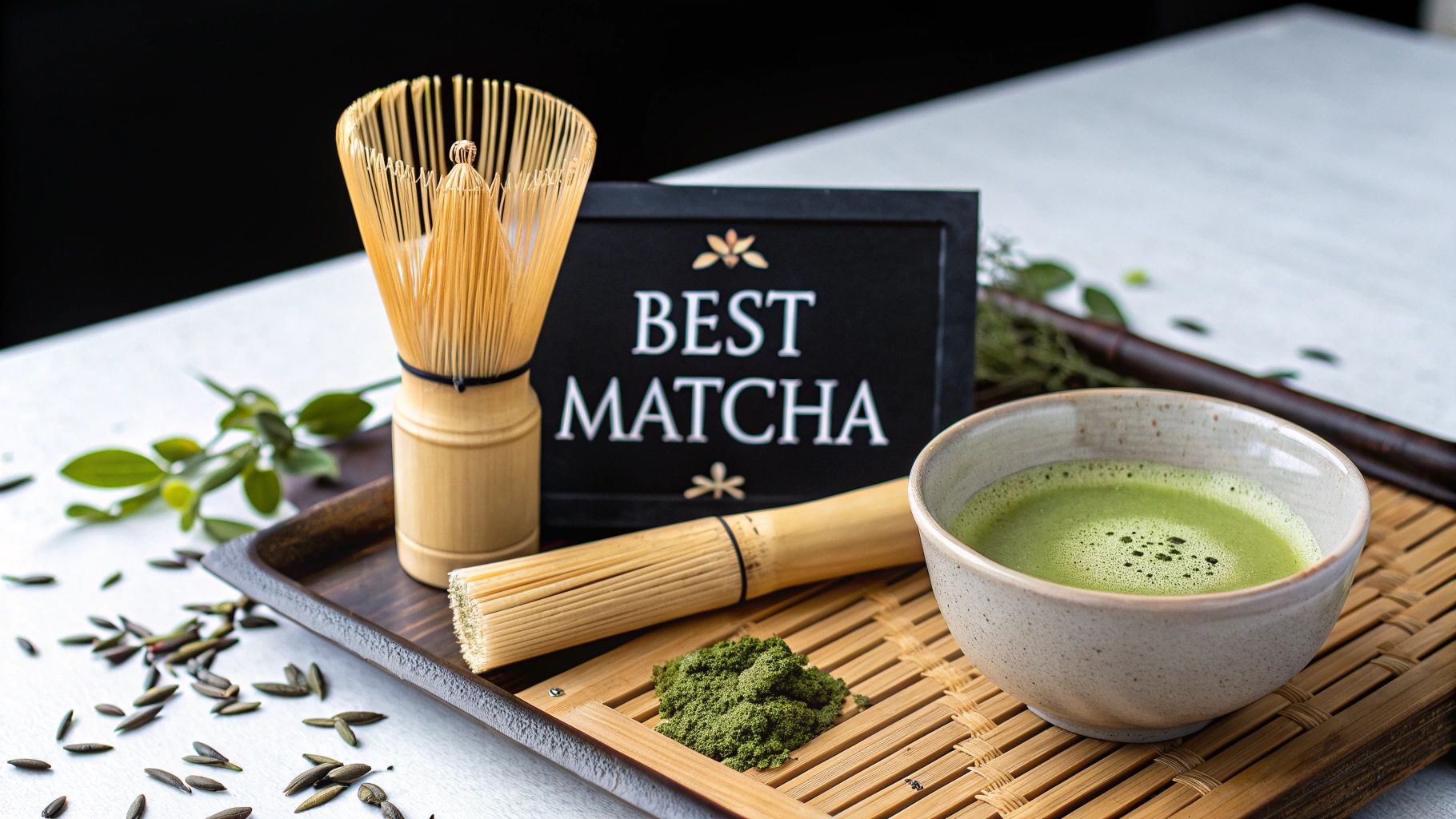
Discover how to choose the best ceremonial grade matcha. Learn tips, benefits, and brewing secrets for your perfect, smooth cup of matcha.
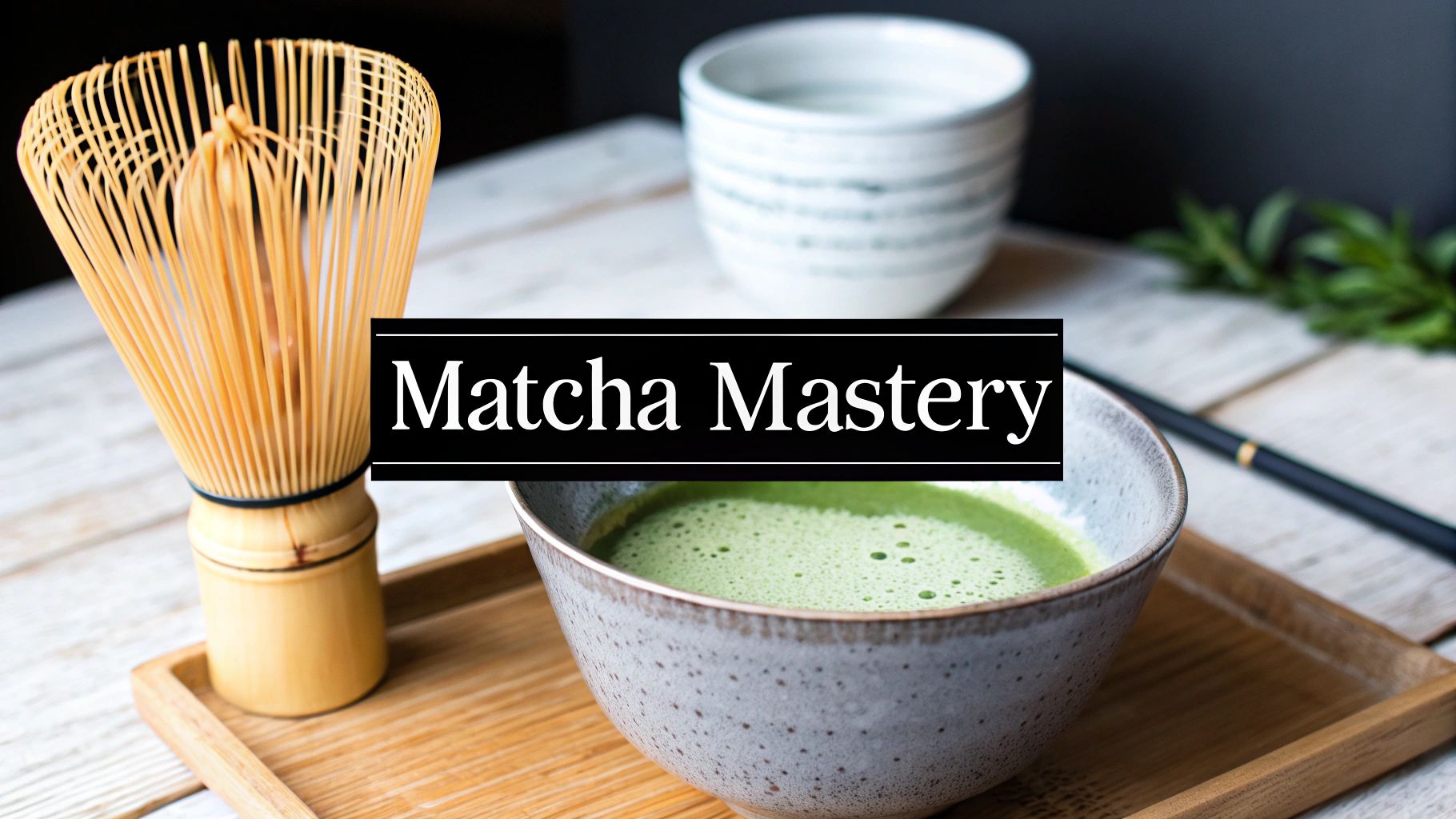
Unlock creamy, frothy matcha. This guide shows you how to choose, use, and care for your matcha green tea bamboo whisk for the perfect cup every time.
